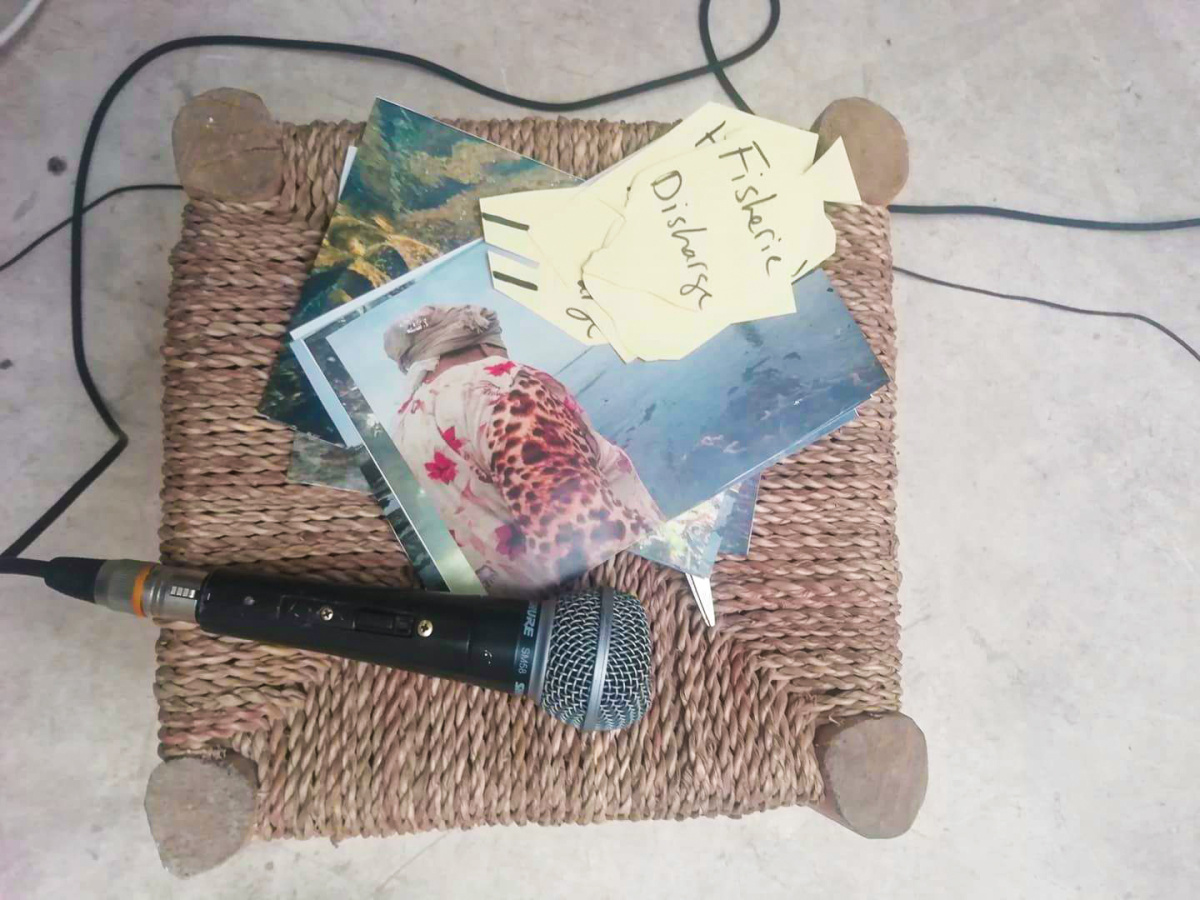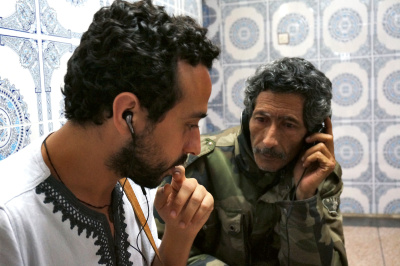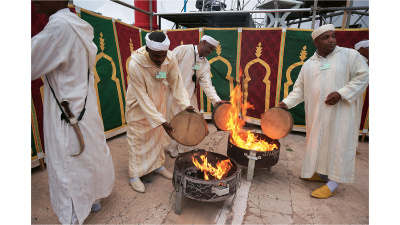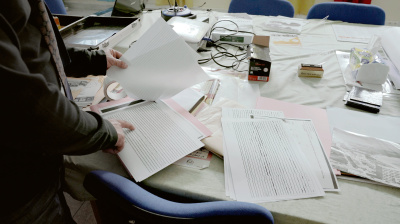Drawing on critical sound studies, ethnographic research, and artistic practice, Gilles Aubry’s book Sawt, Bodies, Species offers multivoiced narratives about acoustic practices in Morocco. His research on the sonic dimensions of our environment ranges from animal, plant, and mineral voices to ritual practices and technological infrastructures. In collaborations with local musicians, artists, and scientists, Aubry explores in experimental settings listening as the basis of «sonic pluralism», a concept he develops throughout the chapters of the book. Read some excerpts of the introduction to his book below, or access the full pdf here.
This book emerged from a series of encounters and exchanges in, through, and about sound in Morocco between 2012 and 2019. I initially engaged in this project through an invitation as a sound artist to create a piece on the 1959 Paul Bowles Moroccan Music Collection for an exhibition. I traveled to Tangier to access digital copies of the recordings made by Bowles fifty-three years earlier, covering various genres of ethnic music. My first encounter with «Moroccan sound» was thus doubly mediated: by technological reproduction, and at the same time by Paul Bowles’s own sensitivity and ideas on music and Moroccan culture. Listening to these recordings with people from Tafraout revealed a multiplicity of positions from which they could be interpreted today: as musical examples of an initiative in cultural preservation; as an aural souvenir of deceased family members and acquaintances; as objects of aesthetic contemplation; as signs of a past idealized in the name of contested cultural politics; as a case of Western cultural appropriation calling for restitution; and as digital cultural artifacts that could be easily circulated in a participative art project. Although each of these positions were equally valid, they were nevertheless all enabled by the sound recordings themselves, likely reproducing a story in which the West is the main protagonist of a local sound modernity.
(…)
In Sawt, Bodies, Species, I offer an account on sound and listening in Morocco across a wide domain of activities, including musical expression, art, sound archives, urban planning, building techniques, seismology, healing practices, industrial extractivism, and ecology. As the book’s title suggests, my approach supports a pluralist perspective on aurality and ecology, which seeks to establish connections between historically separated fields of sonic knowledge, including ethnomusicology, sound studies, phenomenology, sound art history, acoustic ecology, and North African studies. Sound translates as sawt in Arabic, which literally means «voice», including «sound», and «song». Sound in Morocco thus never quite corresponds with its modern Western understanding as a concept and phenomenon separable from the other senses, which can be technologically measured, reproduced, and commodified. As a manifestation of human or extra-human voice, sawt intimately relates to the body.
(…)
In addressing the relationship between music and sound, ethno-musicological scholarship has interpreted «music» primarily as a dimension of cultural identity and territorial belonging, often without considering «sound» as a social and symbolic practice operating in concrete, material environments (Frishkopf and Spinetti 2018). On the opposite, the materially and technologically inclined field of sound studies has remained largely Eurocentric so far, arguably sustaining universal categories of listening subjects (secular, white, and middle-class), of urban spaces characterized by sharp divisions between public and private space (the global city), and of notions of sound itself (Steingo and Sykes 2019). Despite a growing interest in «Indigenous» and «ethnic» knowledge and expression, institutional sound art equally seems reluctant to question the coloniality of its modernist canon, sustained by a number of «invisible» aesthetic conventions (Groth 2020).
(…)
The necessary re-mapping of aural knowledge and practices across these disciplines implies not only a questioning of abstractions such as «modern sound», «space», and «technology». It also involves a deeper re-examination of Western concepts inherited from the Enlightenment period, including «subjectivity», «embodiment», «the human», and «nature». As the Moroccan poet and activist Abdellatif Laâbi (1966) aptly remarked, «colonial science cannot be accepted, nor rejected»; therefore it must be «digested», and from there it can be re-evaluated. My research in Morocco is an attempt to participate in this conversation from my position as an artist and sound scholar.
Sonic Pluralism
Each of the six chapters of the book discusses a particular aural field from which I engage in a reflection on the coloniality of sound, knowledge, and power in Morocco. These fields do not refer individually to a single point in place and time and they can be better described as heterogeneous assemblages of signs, materials, affects, and narratives, linked together across time and space through a dense web of relations. These assemblages progressively emerged through exchanges, conversations, and interventions with a number of local artists, musicians, scientists, and other people – mostly in rural and peripheral regions of Morocco. Listening was always a central modality of these exchanges. To speak with Lucia Farinati and Claudia Firth (2017), I was «interested in exploring what listening can do», as it takes place in individual and collective processes concerned with the possibility of social, political, and ecological change.
This experience gave me a sense of what I call «sonic pluralism», that is a capacity to combine conceptually distinct notions of sound. In a strict sense, sonic pluralism refers to a kind of aural syncretism, that is an amalgamation of different epistemologies manifested through aural practices. Sonic pluralism thus simultaneously refers to the constitutive plurality of the postcolonial aural field and to people’s ability to act upon their own listening in order to find new meanings in aural experience. Although sonic pluralism may afford in principle endless possibilities of positioning oneself in relation to sound, these possibilities appear, however, constrained in practice by the particular historical position of listening subjects. My examples attests to people’s concrete efforts to emancipate from perceptual and epistemological schemes which are often felt as oppressive. Sonic pluralism therefore refers to people’s ways of questioning the limits of what can be perceived from one’s particular position, in order to sometimes better circumvent these limits. This questioning may take different forms, as the examples from my case studies demonstrate.
(…)
On a sound epistemological level, sonic pluralism in my study pertains to examples of direct engagement with recording technology and colonial music archives. Local initiatives open up new perspectives on colonial sound epistemology, raising questions about the «erasure effects» of ethnographic recording, about racist ideas and misrepresentation of «native cultures», and about sound itself as a modern Western technological concept. By drawing on multiple epistemologies, sonic pluralism participates in attempts to re-purpose sonic knowledge for local needs; this entails a negotiation about the relationship between musical expression, knowledge, technology, and history (Chapter I and Chapter II). At a subjective and experiential level, sonic pluralism informs people’s personal experimentation with listening and sounding; this frequently involves liminal aural experience, which in my examples is manifested in transcultural sound encounters (Chapter II), in popular Sufi healing practices (Chapter IV), and in sound artistic experiments at the limits of audition (Chapter V and Chapter VI). As such, sonic pluralism involves processes of subjective redrawing and self-formation; the body appears as a site from which the perceived fragmentedness of the self can be reworked, by drawing on locally relevant knowledge, spiritual practices, or artistic strategies. In the domain of ecology, sonic pluralism pertains to processes of co-formation between people and their environment. In rural areas in particular, environmental listening mirrors locally significant symbolic representations of space, which occasionally conflict with technocratic modes of land management (Chapter III and Chapter V) and with industrial extraction of «natural resources» (Chapter VI).
(…)
Sonic pluralism reveals alternative genealogies of sound and listening, which in my examples can be traced back to Islamic scholarship, Sufi practices, Berber-Amazigh cosmologies, along with other locally significant knowledges. This more-than-sonic approach offers a new perspective on aurality in Morocco, also informing alternate narratives on sonic modernity in North Africa. Sonic pluralism, ultimately, refers to the ever-changing ontological status of sound itself. Sound’s material, symbolic, affective, and aesthetic dimensions are reworked by people through listening and sounding practices. As a result, sound in Morocco is continuously becoming out of itself; if bodies carry histories of embodiment within themselves, so too does sound. Sound, as «sawt», is thus always a «sound body». Sound «in-itself», as an autonomous phenomenon that can be observed from the outside, is de-centered in my study; it appears even more as a particular product of modern Western subjectivity, despite its persistence in contemporary discourses.
(…)
Dimensions of Sonic Pluralism
Sonic pluralism recapitulates my attempts to think sound and aurality together with the terms of modernity and coloniality in Morocco. On the level of social agency, sonic pluralism amounts to a form of negotiation and mediation between opposing tendencies in society, and between conflicting knowledges. As a dimension of subjective formation and embodiment, sonic pluralism participates in individual and collective processes of self-formation and governance. Sonic pluralism is particularly indebted to Walter Mignolo’s (2011) pedagogical principle of «border epistemology». If being appears irremediably entangled with the «colonial matrix of power and knowledge», the body offers a site from which it becomes possible to re-work the borders of these entanglements. Sonic pluralism is concerned with such processes and translates them into the aural domain. I also draw on the notion of «performativity», amply discussed in gender studies (Butler 1990) and in artistic research (Bolt 2016). The transformative power of sonic pluralism is expressed in people’s «acts» of listening and sounding, aimed at questioning and shifting social conventions. The principles of agency, border epistemology, and performativity generally inform my interpretation of aural practices as sonic pluralism. In the following, I provide a number of examples from my case studies to support this interpretation. For the sake of clarity, I have grouped these examples according to four dimensions of sonic pluralism: aural mediation, self-governance, aural co-domestication, and aesthetics.
Sonic Pluralism as Aural Mediation
The notion of «mediation» in sonic pluralism pertains to local modes of engagement with sound technology, as well as to processes of negotiation between different epistemologies of sound and listening. Early postcolonial anthropological studies of technology have already stressed how colonial subjects understood and «indigenized» foreign technologies in their own conceptual schema. Frantz Fanon (1959) provides a remarkable example with his account on the use of the radio by the Algerian resistance during the war of independence. Radio as a foreign technology was culturally «digested» in connection with the national struggle, he notes, turned into a fighting instrument for the people and a protective organ against anxiety.
(…)
Sonic Pluralism as an Expression of Self-Governance
Attending to people’s daily activities during my research in Morocco gave me a sense of how central sound and listening are to local ways of knowing and being. Steven Feld’s (2017) concept of «acoustemology» was particularly helpful for describing sonic knowledge surfacing in non-musical activities and in people’s interactions with their environment. If cultural music studies often tend to produce abstract representations of music practices as «cultural texts» (Goodman 2005), acoustemology engages with sound and listening as a simultaneously social and material process, and as an «experiential nexus of sonic sensation» (Feld 2017). My own approach is an attempt to operate between sonic experience, knowledge, and representation, without losing sight of the vectors of power and difference that largely determine these borders. This brought me to consider sound in relationship with embodiment, an aspect addressed by a number of studies on sound and gender in Morocco.
(…)
Sonic Pluralism as Aural Co-Domestication
(…) Since the 2000s, discourses on sound ecology increasingly refer to debates on the effects of anthropogenic activities on climate change and biodiversity, aka «the Anthropocene» (Davis and Turpin 2015). As many authors argue, the devastation that characterizes the Anthropocene derives from a particular nexus of epistemic, technological, social, political, and economic entanglements with capitalism (Latour 2004; Morton 2009; Haraway 2016). As a mode of accumulation based on the brutal exploitation of natural resources, Hamouchene (2019) similarly sees the cause of environmental damage and social injustice in extractivism. In Morocco, he notes, contemporary extractivism relies on activities which overexploit land, water, minerals, and biodiversity, such as agribusiness, intensive forestry, industrial fish farming, and mass tourism. It is facilitated by «a society with limited democratic rights» and operationalized via neoliberal plans promoting private investment.
Researching environmental sound provided a fertile ground for deeper engagement with the modes of binary thinking constitutive of modern Western subjectivity. Based on dichotomies such as nature vs culture, body vs mind, private vs public space, etc., binary thinking does not only seem increasingly limited for apprehending and representing certain realities. It also appears hegemonic, in its effects both on the environment and on a large part of the world’s human population, indeed as an ideological cause of the Anthropocene.
(…)
Sonic Pluralism as Aesthetics
On the level of aesthetics, sonic pluralism in my study primarily relates to the artistic strategies and aesthetic conventions mobilized during the research process. This includes my own practice and position as a sound artist, as well as interventions developed in collaboration with other people in Morocco. The collaborative principle was established as part of the project methodology from the very beginning, in order to enable a pluralist perspective on sound and aurality. Sonic pluralism therefore appears as a dimension of the «transcultural» learning process between the research participants, in which differences in position were «made visible and negotiated» (Suhr and Willerslev 2013). This process importantly relied on a practical engagement with sound and listening – a number of joint interventions to which we could refer afterwards in our conversations. Different kinds of art practice have informed these exchanges over the years, including listening sessions, sound and video documentation, composing and editing, site-specific experiments, workshops, commissions, as well as public performances, talks, and exhibitions.
Collaborative Artistic Research
As a far-reaching methodological concept for the co-production and mediation of knowledge in anthropological and artistic research, «collaboration» has been key to my project since the beginning (Marcus 2006; Papastergiadis 2012). Each of the aural fields discussed in the chapters have emerged from observations, conversations, and experiments carried out with local artists, musicians, scientists, and other people. In most cases, these partnerships were based on an initial agreement to engage with specific places and situations, without knowing in advance what exactly would define the terms of our collaboration. We were obviously aware of each other’s practice and interests, and sound was not always the starting point of our interactions. The subject matter was often defined by my collaborators’ current focus: the archival research initiated by the Agadiri musician Ali Faiq on the French Speech Archives informed our exchanges on colonial sound epistemology, leading to additional sound experiments and recordings (Chapter I and Chapter III); Ramia Beladel’s engagement as a performing artist with popular Sufism provided a starting point for our joint research on healing practices in the Jbala region (Chapter IV); Abdeljalil Saouli’s art practice and experience with vernacular building techniques triggered our experiments in stone sounding (Chapter V); Younes Boundir’s scientific observations on seaweed and pollution informed our collaboration on the western Atlantic coast (Chapter VI). By being responsive to my partners’ needs and interests, and by aligning in part my own research to their projects, collaboration between us turned into a «co-creative» process of mutual learning (Ferguson et al. 2015; Alexandra 2017). Later on, some of these projects came to include more people through participatory modes of intervention, involving music and dance groups in Ait Milk and Tafraout, art communities in Marrakech and Moulay Bouchta, and a group of seaweed-harvesting women in Sidi Bouzid.
Accompanying Audio and Video Essays
Together, the six chapters trace a larger constellation of aural fields intersecting each other culturally, epistemologically, historically, and, to a lesser extent, geographically. Each chapter provides a link to a corresponding audio or video.
(…)
These works do not simply document or illustrate my research. Rather, they are the outcome of an aesthetic «theory-practice» (Lundström 2008) based on performative and interventionist strategies. Subject matter was not chosen, but produced in the works as part of an open research process, often preceding my analysis. As a result, these audio and visual essays further complicate – and at times may even contradict – my written interpretations in this book. The interplay between these elements may reveal yet other dimensions of sonic pluralism, providing a starting point for future conversations in sound studies and sound art.
+++ read the full introduction +++




